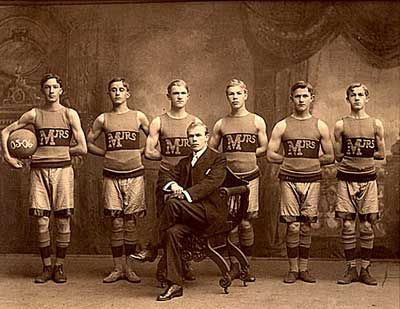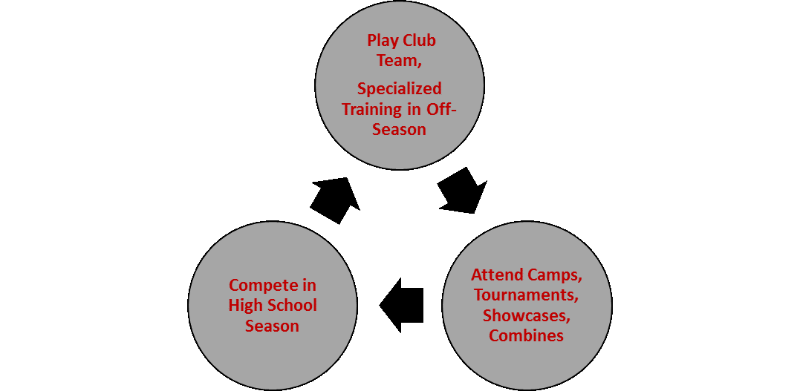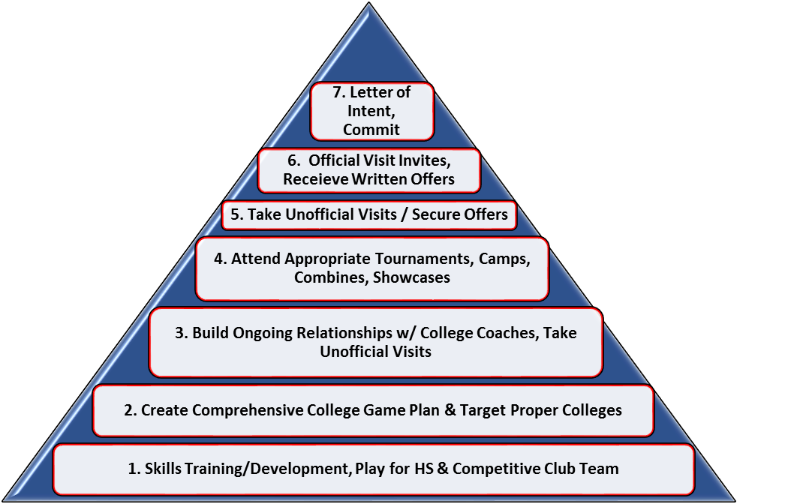College Recruiting has changed…Your Approach may be Outdated!
Posted by SportsForce in College, Inspiring Stories, Recruiting, Tips & Advice, tags: best-fit schools, club team, college coach, College Coaches, college recruiting, college recruiting game plan, college recruiting model, High School, hope strategy, outdated 1990's approach, scholarship, student athletes, success pyramid
In the 1990’s, the surge of competitive youth sports and club teams exploded in the United States. Since that time, joining a competitive club team and attending showcase tournaments or camps have become the dominant choice of more serious middle school and high school student-athletes. The driving motivation is typically to improve their skill sets, compete year round and ultimately enhance their college recruiting opportunities.
Due to NCAA recruiting restrictions and minimal recruiting budgets, college coaches have relied heavily on the ability to evaluate student-athletes at large tournaments, showcases, camps and combines. For the past 20 years, most families of high school student-athletes, have (knowingly or unknowingly) aligned their approach to college recruiting with the club team and tournament experience to look like the model listed below:

Freshman Year: The student-athlete has a high level of passion and desire to excel in their chosen sport. They commit to spending additional hours on personal training and skill work, or hire a sport specific specialist to help. At this point, they have most likely already joined a club or travel team to compete outside of the high school season and are often attending numerous tournaments, camps, combines or showcases annually. As the year progresses, the student-athlete goes on to play for their high school team. The hope is that their improved skills and abilities catch the eyes of college coaches in attendance at one of their competitive events.
Sophomore Year: Repeat the process/cycle
Junior Year: Repeat the process/cycle
Senior Year: Repeat the process/cycle
The tragedy taking place today, is that most student-athletes and families are still following this outdated 1990’s approach to college recruiting, or what we call the “hope” strategy.
Why can this recruiting approach be so limiting and usually ineffective for the more than 8 million high school student-athletes in the U.S.?
The importance of joining a competitive club team or playing in appropriate tournaments is not in question here. They can greatly help to advance your son or daughter’s skills in the off-season, or possibly assist in being evaluated by a college coach at a large showcase event. The club team coach may even know a few college coaches they can call on behalf of your son or daughter to provide additional feedback.
However, the approach families take to college recruiting is being challenged in three key areas.
1.) First, most club teams simply do not possess all of the necessary tools, time or resources needed to personally mentor and guide each of its players over a two, three or even four year period, let alone helping them to secure and manage multiple offers.
2.) Second, the majority of parents do not understand how to effectively promote their son or daughter to right-fit college coaches and programs.
3.) Last, families are spending thousands and thousands of dollars each year to attend multiple ID camps, tournaments, showcases, or combines in the hopes of generating interest or “looks” from college coaches for their son or daughter with too often, little or no results.
Unfortunately, most parents don’t fully understand how coaches evaluate and recruit at these events. There are normally several hundred, or maybe over a thousand players in attendance at a showcase tournament and college coaches do not have the ability to scout every player.

John Wooden, former UCLA basketball coach and the creator of the Pyramid of Success is a huge inspiration to many coaches, players and parents across the world. Thinking about the college planning and recruiting process, it struck me to create a “Pyramid of College Recruiting Success” diagram. The purpose is to help make crystal clear what the different stages of the climb up the pyramid are, and the keys to its success.
This pyramid presents families and their student-athletes with the opportunity to begin taking more control over their college recruiting options and choices. The biggest difference between this approach and the one started in the 1990’s is the importance of creating a comprehensive college recruiting game plan. It should include specific goals and strategies that may ultimately help to generate multiple offers from best-fit schools. The initial target list schools should at least match your son or daughter’s athletic skills, academic abilities, potential playing time opportunities, academic goals/majors, school location/size, and financial budget (note: most scholarships are not full-rides).
The other major focus point is centered on the importance of the student-athlete taking the time to begin building and sustaining relationships with college coaches as early as possible. A student-athlete should be developing an ongoing and “personal” dialogue with 10-12 college coaches, or maybe more. As college coaches and student-athletes advance through the recruiting process together, it is only natural that some coaches will be more interested in certain players over others. The opposite also takes place as student-athletes begin to narrow their choices of schools/sports programs that best fits their needs. Too often, student-athletes make the fatal mistake of placing all of their recruiting focus and energy on one or two colleges, only to be left out entirely when offers are made because the coach recruited and offered a roster spot or scholarship to a different player.
One of the least efficient and most costly ways to being recruited is by attending all of the tournaments, camps and showcase events you hear about. That can be a very expensive and time consuming endeavor for your entire family. The goal, rather is to pinpoint those competitive events where your potential best-fit college coaches will be in attendance and to build a relationship with them prior to the event. Again it’s important to outline what a best-fit school and sports program looks like for your son or daughter. As previously mentioned above, these priorities should include things like: athletic and academic abilities, potential playing time, opportunity to turn professional in their sport (if desired or realistic), available majors, future career networking opportunities, location, size and potential financial obligations or savings.
It’s very important to ask yourself what your family’s college recruiting game plan is, and if it is clearly defined. Everything starts with an honest evaluation with where you and your child are in the process.
If done properly, this new approach could exponentially increase your son or daughter’s chances of being recruited and may ultimately help in securing multiple offers from their best-fit schools.
SportsForce is a College Recruiting Advisory Group based in San Diego, CA. Our entire team of college recruiting advisors dedicate their passion, time and attention to evaluating, educating and guiding qualified student-athletes and families through the college planning and recruiting process.




